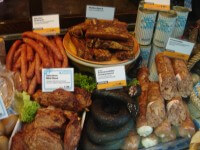 According to the Oxford Companion to Food, charcuterie “literally means cooked meat, from the French chair cuit. It now refers almost solely to pork products, which are sold by a specialist charcutier and include hams, sausages, sausage meat, and forcemeats…” For many of us, charcuterie is a section on menus at trendy restaurants we’ve only begun to notice in the last several years. Ten years ago, where did all that forcemeat go?
According to the Oxford Companion to Food, charcuterie “literally means cooked meat, from the French chair cuit. It now refers almost solely to pork products, which are sold by a specialist charcutier and include hams, sausages, sausage meat, and forcemeats…” For many of us, charcuterie is a section on menus at trendy restaurants we’ve only begun to notice in the last several years. Ten years ago, where did all that forcemeat go?
By and large it didn’t exist. But there’s been a surge of late—both in consumers who seek out housemade terrines and pâtés that appeal to their more adventurous side as well as in chefs who want to use every part of a pig and who yearn to be artisans. Michael Ruhlman has written a book, Charcuterie: The Craft of Salting, Smoking and Curing, coauthored by Brian Polcyn. And in last week’s Washington Post, Cathy Barrow profiled chef and butcher Jason Story, who makes his own sopressata, tasso, and the like, right in Petworth:
“Nobody, not once, showed me how to do this,” [Story] says, wiping the blade of his knife with a clean towel.
While restaurant chefs enhance their menus with house-made, artisanal meats, culinary schools are just beginning to respond with the broader kind of training required. Most of the schools in the States educate students on the cuts of meat, portioning and buying, as well as garde manger, literally “keep to eat,” which includes pâtés and fresh sausages. But one chef said that a chicken was the only animal he learned to break down at culinary school; another said about 31/2 hours were devoted to learning those familiar charts of meat cuts.
But will we start seeing a rise in butcher shops? Local butchering fell into decline because of supermarkets—a convenient source of one-stop shopping where most of the meats have already been precut (as noted in Barrow’s article). Roger Horowitz notes in Putting Meat on the American Table that based on the 1929 census, there were 44,000 butcher shops nationwide. Today, there are a handful of places in the D.C. area (Wagshal’s, the Organic Butcher, for example). It will be interesting to see where all this leads us (or won’t lead us, depending on the economy).
Photo note: I took this picture in 2009 at a Schlemmermeyer’s display case in Stuttgart. Quite literally a sausagefest.